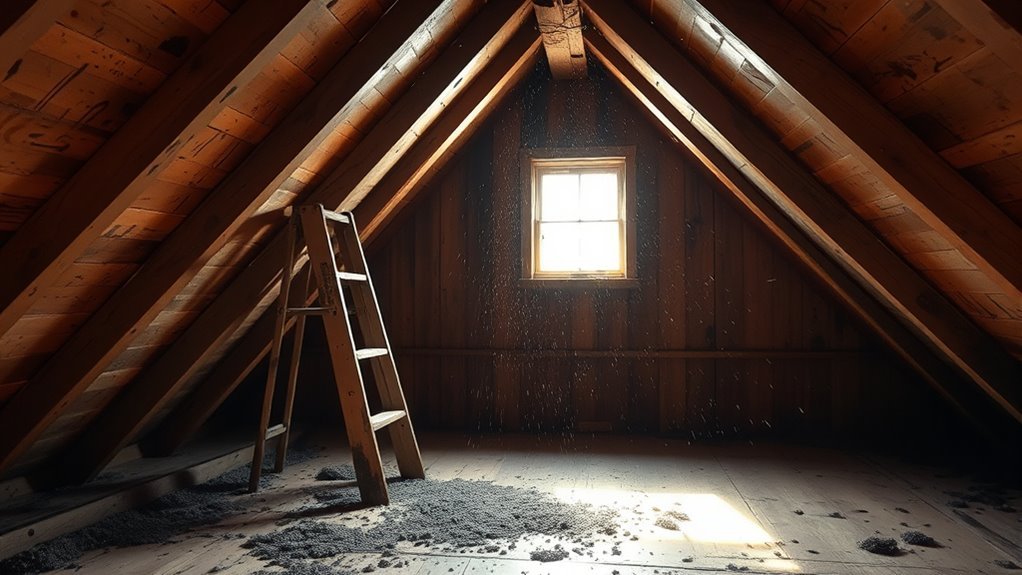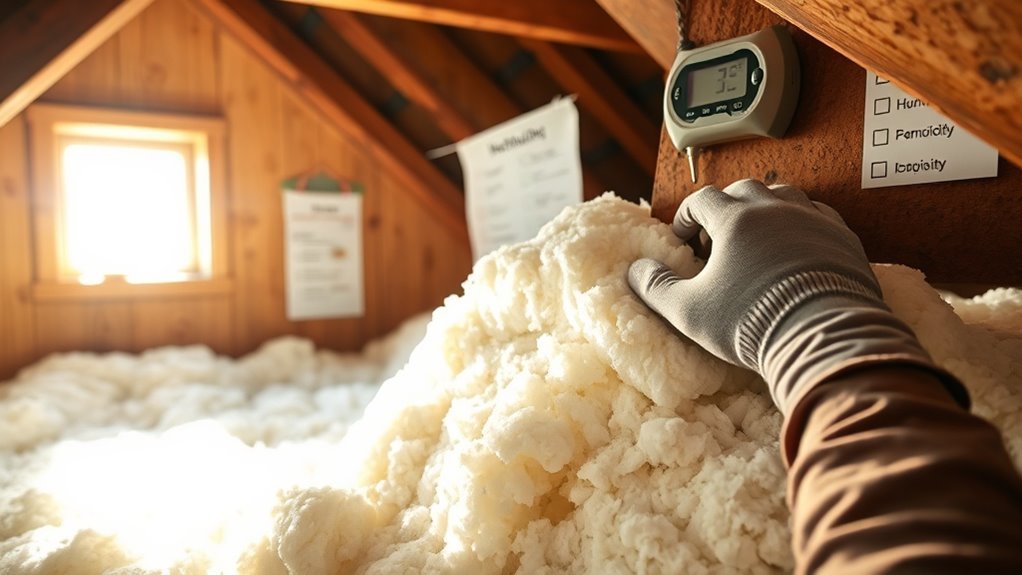Daily Maintenance Tips for Attic
You should regularly check your attic for moisture, mold, and pest signs to prevent damage and health risks. Keep vents clear to guarantee proper airflow and inspect insulation for gaps or dampness. Seal any air leaks around vents or pipes to boost energy efficiency. Also, keep your attic clean and clutter-free for better access and airflow. Maintaining these habits daily helps protect your home’s structure and comfort. Explore more tips to keep your attic in top shape.
Inspect for Signs of Moisture and Mold

Before you plunge into any attic maintenance, you should carefully inspect for signs of moisture and mold. Moisture detection is your first line of defense against costly damage and health risks. Check for damp spots, discoloration, or a musty odor—these are clear indicators that moisture has taken hold. By catching these early, you’re actively practicing mold prevention, keeping your attic dry and safe. Use a flashlight to scan hidden corners, and don’t forget to inspect insulation and wooden beams. If you spot any mold, act quickly to remove it and address the source of moisture. Staying vigilant with moisture detection empowers you to maintain a healthy attic environment, preserving your freedom from expensive repairs and indoor air quality issues.
Check and Maintain Attic Ventilation
You should start by inspecting all vent openings in your attic to guarantee they’re intact and functioning properly. Make sure to clear any blockages like debris or insulation that could restrict airflow. Proper ventilation helps prevent moisture buildup and keeps your attic in good condition.
Inspect Vent Openings
One essential step in attic maintenance is inspecting vent openings to verify proper airflow. By regularly checking the ventilation types—such as ridge, soffit, and gable vents—you ascertain that air moves freely, enhancing airflow efficiency. This prevents moisture buildup and keeps your attic space healthy and dry.
| Ventilation Type | Location | Maintenance Tip |
|---|---|---|
| Ridge Vent | Roof peak | Check for debris or damage |
| Soffit Vent | Eaves | Confirm openings aren’t blocked |
| Gable Vent | Attic ends | Inspect for pest intrusion |
| Turbine Vent | Roof surface | Verify rotation and clearance |
Inspecting these vents regularly helps maintain your attic’s freedom from moisture and structural issues, keeping your home comfortable and safe.
Clear Vent Blockages
After inspecting your attic vents, the next step is to clear any blockages that might restrict airflow. You want your ventilation systems working efficiently to keep your attic fresh and free from moisture buildup. Debris like leaves, dust, or even nests can clog vents, reducing the air flow needed to regulate temperature and prevent damage. Grab a flashlight and a brush or vacuum to carefully remove anything blocking the openings. By maintaining clear vents, you guarantee your attic breathes properly, which protects your home and gives you the freedom to avoid costly repairs. Don’t overlook this simple task—keeping your ventilation systems clear is key to a healthy attic and peace of mind.
Monitor Insulation Condition and Coverage

You should regularly inspect your attic insulation for any signs of wear or damage. Make sure the coverage is even and there are no gaps that could reduce its effectiveness. Also, watch out for moisture or mold, which can compromise insulation quality and your home’s energy efficiency.
Inspect Insulation Integrity
Checking your attic’s insulation at least twice a year can help you spot issues before they become costly problems. You’ll want to examine the insulation types used and verify they’re still performing well to maintain energy efficiency. Look for signs of compression, moisture, or pest damage that can reduce effectiveness.
| Insulation Type | Common Issues | Impact on Energy Efficiency |
|---|---|---|
| Fiberglass | Settling, moisture | Decreased R-value |
| Spray Foam | Cracks, gaps | Air leaks reduce efficiency |
| Cellulose | Compression | Loss of thermal barrier |
Check Coverage Uniformity
While inspecting your attic’s insulation, it’s important to secure the coverage is uniform throughout the space. Uneven attic insulation can create cold spots and reduce energy efficiency, limiting your home’s comfort and your freedom to control the environment. Perform a thorough coverage assessment by visually scanning the entire attic floor. Look for thin areas or gaps where insulation might be missing or compressed. These weak spots compromise your home’s thermal barrier, allowing heat to escape or enter. If you spot inconsistent coverage, plan to add insulation to those areas promptly. Maintaining consistent attic insulation not only saves energy but also keeps your living space comfortable year-round. By regularly checking coverage uniformity, you secure your attic remains a reliable shield against temperature fluctuations and energy waste.
Identify Moisture or Damage
Ensuring your attic insulation is evenly spread is just one part of maintaining an efficient thermal barrier. You also need to be vigilant about moisture detection and damage assessment. Moisture can sneak in from leaks or poor ventilation, leading to mold or rot that compromises insulation and structure. Regularly inspect your attic for any damp spots, discoloration, or musty smells—signs moisture has taken hold. For damage assessment, look out for crushed or displaced insulation and any signs of pest activity. Catching issues early lets you fix them before they spiral into costly repairs. Staying proactive means your attic stays dry, your insulation works effectively, and you keep your home comfortable and energy-efficient without being trapped by unexpected problems.
Seal Air Leaks and Gaps

Sealing air leaks and gaps is one of the easiest ways to improve your attic’s energy efficiency and comfort. When you focus on air sealing, you’re not just preventing drafts—you’re taking control of your home’s temperature and reducing energy waste. Start by inspecting common trouble spots like around vents, pipes, and attic hatches. Use caulk or expanding foam to seal these gaps tightly. By doing this, you’ll minimize heat loss in winter and keep hot air out in summer, giving you more freedom from high energy bills and uncomfortable rooms. Remember, a well-sealed attic supports your goal of an efficient, cozy home without relying heavily on heating or cooling systems. Take charge, and enjoy the benefits of smart air sealing.
Keep the Attic Clean and Clutter-Free
Because a cluttered attic can block airflow and hide problems like leaks or pests, keeping it clean and organized is key to maintaining its efficiency. You’ll want to embrace attic organization by regularly sorting through stored items and discarding what you no longer need. Opt for smart storage solutions like clear bins and sturdy shelves to maximize space without crowding the area. This approach not only frees up room but also makes it easier for you to spot potential issues early. Staying on top of clutter lets your attic breathe and keeps it accessible, giving you peace of mind and the freedom to use the space as you please. Keep it tidy, and your attic will continue working efficiently without unnecessary obstacles.
Inspect Roof and Structural Components
Once your attic is clean and well-organized, it’s easier to spot issues with the roof and structural components. You’ll want to carefully examine the attic framing for any signs of damage or sagging. Cracks, warping, or moisture stains around beams can signal problems that need addressing before they worsen. Don’t forget to check the roof shingles visible through the attic ceiling for missing, cracked, or curled edges. These can lead to leaks that damage your space and freedom to use it as you wish. Regularly inspecting these elements helps you maintain your attic’s integrity and avoid costly repairs later. Taking control of these checks empowers you to keep your attic safe and structurally sound, so your home feels like a place where you’re truly free.
Control Pest Activity and Prevent Infestations
Although pest activity might seem minor at first, it can quickly turn into a serious problem if left unchecked. To maintain your attic’s freedom from unwanted guests, focus on pest proofing and infestation prevention. Seal cracks, install screens, and keep the space clean. Here’s a quick guide to keep your attic pest-free:
| Pest Type | Prevention Method | Signs to Watch For |
|---|---|---|
| Rodents | Seal entry points | Droppings, gnaw marks |
| Insects | Remove debris | Sawdust, nests |
| Birds | Install netting | Feathers, droppings |
| Squirrels | Block vents | Scratching noises |
Stay proactive and you’ll protect your attic’s integrity and enjoy peace of mind without restrictions.
Schedule Regular Professional Inspections
To keep your attic in top shape, you should schedule regular professional inspections. These inspections are key to maintaining attic safety by identifying hidden issues like moisture buildup, structural damage, or electrical hazards before they escalate. You’re free to enjoy peace of mind knowing experts are checking the space thoroughly. The ideal inspection frequency is typically once a year, but if your attic experiences extreme weather or has had previous problems, more frequent visits might be necessary. Professionals have the tools and expertise to spot trouble you might miss, ensuring your attic stays safe and efficient. Don’t wait for a problem to arise—regular inspections help you maintain control over your home’s condition and protect your investment.
Frequently Asked Questions
How Often Should Attic Lighting Be Replaced?
You should replace your attic bulb when it burns out or shows signs of dimming, as the lighting lifespan varies depending on the bulb type. LED bulbs can last up to 25,000 hours, so you won’t need to change them often, giving you freedom from frequent upkeep. Keep an eye on your lighting’s performance, and swap bulbs only when necessary to maintain a well-lit attic without unnecessary hassle.
Can Attic Temperature Affect Home Energy Bills?
Back in the days of steam engines, folks didn’t worry about attic temperature affecting energy bills—but you should. If your attic insulation’s poor, heat escapes in winter and seeps in during summer, hiking your energy costs. By improving attic insulation, you boost energy efficiency, letting you enjoy freedom from skyrocketing bills. Keeping your attic’s temperature regulated means your home stays comfy without draining your wallet or the planet’s resources.
What Types of Storage Are Safe for Attics?
When choosing storage for your attic, you’ll want to focus on durability and protection. Using plastic storage bins is a great way to keep items safe from moisture and pests while maintaining attic organization. You can also opt for clear bins to easily spot what you need without digging around. Just avoid cardboard boxes since they’re vulnerable to humidity. With the right storage, you’ll enjoy freedom from clutter and easy access to your things.
Are There Specific Attic Flooring Materials Recommended?
Oh, sure, you could just toss down some random boards and call it a day, but if you want your attic to feel less like a rickety pirate ship, plywood flooring’s your best mate. It’s sturdy and lets you roam freely without worrying about falling through. Pair that with smart insulation options, and you’ll keep your freedom-loving self comfy up there without freezing or overheating—because your attic should be a fortress, not a freezer or sauna.
How Do I Choose the Right Attic Ladder?
When choosing the right attic ladder, you’ll want to evaluate ladder materials like wood, aluminum, or steel—each offers different durability and weight. Prioritize ladder safety by checking weight limits and ensuring sturdy construction. Think about your space and how often you’ll use it; lightweight materials offer freedom to move easily, while sturdier ones provide long-term reliability. Pick a ladder that fits your lifestyle and keeps you secure every time you climb up.






